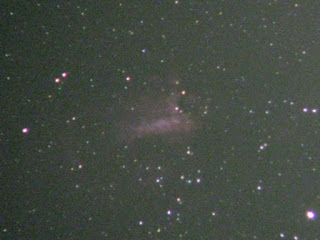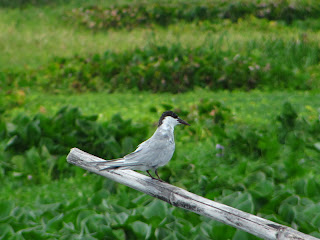Yesterday, I joined the migratory raptor counting activity along with the other members of the Wild Bird Club of the Philippines. When there were no raptors in sight to count, I tried to compare 3 scopes with a friend. The scopes tested are: a 70mm generic scope (+venture achromat), an Orion ST-80 (80mm achromat), and an 80mm Columbia spotting scope. With all three scopes pointed to a common target, a PAGASA wind vane about 20 meters away, we tried to read the small marks (2mm white on black text) stamped on the device. Since all three are achromats, all show a bit of false color at higher magnification. The 70mm shows the least amount of details, the texts are almost unreadable, but it has the best color correction - least amount of purple fringing. Both the ST-80 and the spotting scope showed a generous amount of purple, but it seems the spotting scope has the most amount of red and purple. The texts are barely readable on both 80mm scopes, but it seems the ST-80 is a little bit sharper. My verdict for each category (best to worst):
Color correction: 70mm, ST-80, Spotting scope
Sharpness: ST-80, Spotting scope, 70mm
Ruggedness: Spotting scope, ST-80, 70mm
Portability (lightest to heaviest): 70mm, spotting scope, ST-80
Aesthetic appeal: Spotting scope, ST-80, 70mm
We ended the day with a total of 1900+ raptors on the list. I learned to identify a Chinese goshawk by looking at the dark wing tip and light colored mid-section, thanks to raptor master Jon Villasper.
White throated kingfisher
The next day, I got up early as well and waited for Dennis to arrive before we proceed to hike together. Both of us needs to shed some weight and hiking to the Petroglyph seems to be a way to do it. ;) Along the way, we managed to see some good birds and some blue tailed bee-eater, the first time I saw them in that place.
Some of the images I took:
The owl
Grey wagtail with a full yellow belly.
When I got home from the hike and some rest, I decided to do some optics test again. This time using 3 achromats and a mak. The scopes are: 70mm +venture scope, 80mm Aquila optics, Skywatcher ST-80 and a Skywatcher 102mm mak. The candidates are shown below.

I taped a 20 peso bill on a wall 23 meters away from the scopes as a target and proceeded to do the test. The 3 achromats again showed a bit of color at high magnification, with the 70mm showed the least and the Aquila showed the most. As expected, the mak didn't show any trace of the undesirable purple fringe. For sharpness test, the 70mm could not resolve the name of the president on the bill. The ST-80 barely resolves it, the 80mm Aquila scope performed a little bit better than the ST-80 probably due to a finer focus thanks to its' Crayford type focuser instead of the usual rack and pinion one of the ST-80. All 3 achromats cannot resolve the smaller text below clearly. The mak proves it is far superior to the other candidates and shows a very sharp and well defined "BENIGNO S. AQUINO III" and the text below it "Pangulo ng Pilipinas". My final verdict for each category (arranged from best to worst):
Color correction: Mak, 70mm, ST-80, Aquila 80
Sharpness: Mak, Aquila 80, ST-80, 70mm
Ruggedness: Mak, Aquila 80, ST-80, 70mm
Portability (lightest to heaviest): 70mm, ST-80, Mak, Aquila 80
Aesthetic appeal: Aquila 80, ST-80, Mak, 70mm
The target
The scopes, 2 at a time
The following day, I tried to check the optics of another achromat, a Celestron Powerseeker 80 f/11 scope. It was able to resolve both texts, but still cannot compare to the sharpness the mak provides. It's a long and bulky instrument as well. The color correction, as expected from a long focus achromat, is superior to the 3 short focus achros but cannot beat good ol' mak. :)































































